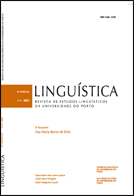Old and new classes of formatives and word formation processes: the case of splintering and fractocompounding
Abstract
The present study describes the classes of formatives and processes of word construction, such as (i) affixation and composition, the most established and stabilized, (ii) blending/lexical fusion and clipping/shortening, less represented than the previous ones, and (iii) some of the most innovative, such as those operating with splinters. The legitimation of these formatives, with origin in non-morphememic segments that acquire, as a result of reanalysis, morfolexical status, poses the problem of the nature of the processs in which they operate. Once the autonomy from blending is established, the proximity of splintering to affixation and composition is discussed, and the fractocomposition is proposed as the subclass in which splinters can be enrolled, together with other fractoformatives. In order to characterize these formatives, in this study the processes’categorization is based on the ±bound, ±fragmented/splintered and/or ±clipped nature of the formatives.
References
Alves, R. S., Gonçalves, C. A. V. 2014. O processo de formação de palavras com os splinters -nese, -nejo e -tone. Entretextos (UEL) v. 14. 27-42.
Andrade, K.; Rondini, R. 2016. Cruzamento vocabular: um subtipo da composição?. D.E.L.T.A. Documentação de Estudos em Linguística Teórica e Aplicada (Online), v. 32. 861-887.
Barrena Jurado, A. 2019. A study on the ‘wordgasm’: the nature of blends’ splinters. Lexis v. 14. 1-49.
Basílio, M. 2013. Formação e classes de palavras no português do Brasil. São Paulo: Contexto.
Bauer, L. 2004. A Glossary of Morphology. Edinburgh: Edinburgh University Press.
Bauer, L. 2005. The Borderline Between Derivation and Compounding. In W. U. Dressler (ed.) Morphology and Its Demarcations. John Benjamins. 97-108.
Bauer, L.; Lieber, R.; Plag, I. 2013. The Oxford Reference Guide to English Morphology, Oxford: Oxford University Press.
Berman J. M., 1961. Contribution on Blending. In Zeitschrift für Anglistik und Amerikanistik 9, Walter De Gruyter. 278-281.
Booij, G., Lehmann, C. ; Mugdan, J. (eds.) 2000. Morphology: An International Handbook on Inflection and Word-Formation. Berlin/New York: Walter de Gruyter.
Cannon, G. 2000. Blending. In: G. Booij, C. Lehmann, J. Mugdan (Eds.), Morphology: An International Handbook on Inflection and Word-Formation. Berlin/New York: Walter de Gruyter. 952-956.
Carvalho, W. B., Gonçalves, C. A. V. . 2015. Sobre piris e guetes: análise morfológica das construções cunhadas a partir de ‘splinters’ de “PERIGUETE”. Fórum Linguístico (Florianópolis) v. 12 n. 4: 930-944.
Corbin, D. 2001. “Préfixes et suffixes : du sens aux catégories.” Journal of French Language Studies v. 11 n. 1: 41-69.
Corbin, D. 2004. French (Indo-european: Romance). In G. Booij et al. (eds), Morphologie/ Morphology. Ein internationales Handbuch zur Flexion und Wortbildung / An International Handbook on Inflection and Word-Formation. vol. 2, Berlin / New York: Walter de Gruyter, [Article 121], 1285-1299.
Dicionário Priberam da Língua Portuguesa [em linha], 2008-2020, https://dicionario.priberam.org/periguete [consultado em 01-02-2021].
Fandrych, I. 2008. Submorphemic elements in the formation of acronyms, blends and clippings. Lexis 2. 103-121.
Gonçalves, C. A. V. 2011. Composição e Derivação: Polos Prototípicos de um Continuum? Pequeno Estudo de Casos. Domínios de Lingu@gem. v. 5, n. 2: 62-89.
Gonçalves, C. A. V. 2013. Na sextaneja com a caipifruta da mãedrasta: o estatuto morfológico dos splinters no português brasileiro contemporâneo. Diadorim, Rio de Janeiro, v. esp., n. 13: 139-158.
Gonçalves, C. A. V. 2016a. Atuais tendências em formação de palavras. São Paulo: Contexto.
Gonçalves, C. A. V. 2016b. Processos ‘Marginais’ de formação de palavras. Campinas: Pontes.
Gonçalves, C. A. V., W. B. Carvalho, K. E. Andrade 2016. Splinters são cruzamentos de cruzamentos? Repensando o estatuto desse constituinte em português. Revista do GEL, v. 13, n. 1: 132-156.
Gonçalves, C. A. V., Andrade, K. E. 2016. A instabilidade categorial dos constituintes morfológicos: evidência a favor do continuum composição-derivação. D.E.L.T.A., v. 32, n 2: 261-294.
Haspelmath, M. 2002. Understanding Morphology. Oxford: Oxford University Press, Arnold Publications.
Heine, B, Claudi, U., Hünnemeyer, F. 1991. Grammaticalization. Chicago: Chicago University Press.
Herculano de Carvalho, J. G. 1974. Teoria da Linguagem. Natureza do fenómeno linguístico e análise das línguas.2 vols.. Coimbra: Coimbra Editora.
Hopper, P., Traugott, E. 1993. Grammaticalization. Cambridge: Cambridge University Press.
Iacobini, C. 2004. Composizione con elementi neoclassici. In M. Grossmann, F. Rainer (eds), La formazione delle parole in italiano. Tübingen: Max Niemeyer Verlag. 69-95.
Lehmann, C. 2015. Thoughts on grammaticalization. 3rd edition. Berlin: Language Science Press.
Lieber, R. 2016. Introducing Morphology, 2nd ed. Cambridge: Cambridge University Press.
Lieber, R., Štekauer, P. (eds.) 2011. The Oxford Handbook of Compounding. Oxford: Oxford University Press. Linguateca.pt https://www.linguateca.pt/CETEMPublico/
Mota, M. A. 2020. Processos de formação de palavras. In E. Paiva Raposo et al., Gramática do Português. Vol. III. Lisboa: Fundação Calouste Gulbenkian, 2820-2825.
Müller, Peter O. et al. (eds). 2015. Word-Formation: An International Handbook of the Languages of Europe, Berlin/New York: De Gruyter Mouton.
Rio-Torto, G. (coord) et al. 2016, Gramática derivacional do português. Coimbra: Imprensa da Universidade de Coimbra.
Rio-Torto, G.; Ribeiro, S. 2012. Portuguese Compounds. Probus 24: 119-145.
Rio-Torto, G.; Ribeiro, S. 2016. Composição. In G. Rio-Torto (ed.), Gramática derivacional do português. Coimbra: Imprensa da Universidade de Coimbra, 461-520.
Rodrigues, A. S. 2001. A construção de postverbais em português. Porto: Granito Editores.
Rodrigues, A. S. Processos de Formação. In G. Rio-Torto et al. 2016, Gramática derivacional do português. Coimbra: Imprensa da Universidade de Coimbra, 102-126.
Spencer, A., Zwicky, A. M. (eds.) 2017. The Handbook of Morphology. Oxford: Blackwell Publishers.
Štekauer, P. 2000. English Word-Formation: A History of Research, 1960-1995. Tubingen: Gunter Narr Verlag.
Downloads
Published
Issue
Section
License
Copyright (c) 2021 Linguística: Revista de Estudos Linguísticos da Universidade do Porto

This work is licensed under a Creative Commons Attribution-NonCommercial 4.0 International License.



